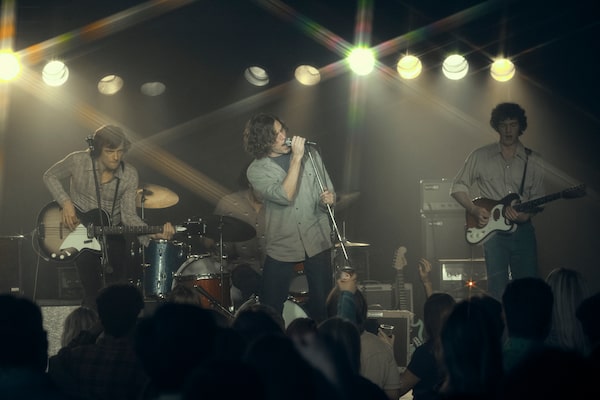
Josh Whitehouse (Eddie), Sam Claflin (Billy), Will Harrison (Graham) in Daisy Jones & The Six.Lacey Terrell/Amazon Prime Video
Taylor Jenkins Reid once described Daisy Jones & The Six as a novel about female art and the importance of women having their own voice. How then, did the author’s themes get so lost in translation for the 10-part TV adaptation?
Reid based her fictional rock biography, which streams weekly on Amazon Prime starting Mar. 3, on Fleetwood Mac and other bands from the seventies. It charts the quick rise and faster fall of the title group and its members, who disbanded after selling out Chicago Stadium in 1979. The story itself is an oral history of sorts, as band members and others who were there at the time recall the events.
The manuscript was so gripping that Lauren Neustadter, Hello Sunshine’s president of TV and film, interrupted company founder Reese Witherspoon’s vacation to snatch the rights a year before the book published in 2019.
How did Neustadter get an advance copy? That would be her screenwriter husband, Scott Neustadter, whom Reid’s manager initially approached. He and fellow 500 Days of Summer scribe Michael H. Weber were then hired to adapt the limited musical series, which finally premieres on Prime Video this week after numerous pandemic-related production delays.
If you’re a book purist, you may agree that hiring the male duo was a mistake. Despite incredible mood-setting cinematography, thousands of beautiful costumes and the spot-on casting of Riley Keough and Sam Claflin as respective band leaders Daisy Jones and Billy Dunne, the first half of the series falls flat.

Riley Keough as the series' namesake character, Daisy.
That’s because of the many liberties Neustadter and Weber take with the story. In the novels, for example, there are six band members comprising the Six. In the series, there are five, due to the elimination of the Pete Loving character. (The band naming itself the Six is explained in Episode 2.)
There are smaller character changes that don’t necessarily affect the story, such as Daisy’s penchant for boots instead of strutting around barefoot, Karen’s (Suki Waterhouse) love of turtlenecks, or Billy foregoing his signature Canadian tuxedo for a leather jacket. There are welcome changes, including a queer-positive storyline. And then there are questionable re-imaginings that alter the course of the story, such as the way Billy’s wife Camila (played by Camila Morrone) reacts to her husband’s rise to fame.
That’s all fine when you consider an adaptation is never meant to be an exact replica of the original. Where this series fails, however, is in capturing the essence of what makes Daisy Jones so compelling, and how her upbringing and early experiences as a musician led to her self-destruction. This show eliminates many of her personal struggles, including her first recording contract and her shady manager – both things that fuelled her initial addictions.
The writers also failed an opportunity to explore the compelling relationship between Daisy and her one true friend in life, Simone (Nabiyah Be). Although it’s difficult to dig into without spoiling the story, integral scenes between Simone and Daisy have been eliminated, and in some cases Billy replaces Simone altogether. Too much of Daisy is fixated on her relationship with Billy, transforming this tale into a love story rather than the complex character study it could have been.

Sebastian Chacon (Warren) in Daisy Jones & The Six.Lacey Terrell/Amazon Prime Video
It’s a real shame, given how absorbing Keough is in the role. But without these backstories, struggles and relationships, Daisy doesn’t come to life the way she could. It’s a struggle to connect with her in the way viewers (and Emmy voters) need to see themselves at least partially represented in a character.
Daisy isn’t the only female character that feels two-dimensional, either. Camila and Karen are just as underserved in both their backstories and struggles, as well as with the friendship they share with each other.
This isn’t to say the show isn’t worth watching, especially as it enters the back five episodes. That’s when lead producer and songwriter Blake Mills saves the day with songs you want to listen to all day (and you can, thanks to the impending Aurora album release).
That music is enough to revive the series and immerse you in the story, to the point where you’re rooting for these characters to succeed just so you can hear them play together one more time. You almost want to be in the crowds they’re playing for, and you begin to believe they’re a real band. Heck, you even begin to buy into the love triangle that you initially despised, because that’s the power of rock and roll, man.
It all crescendos in a powerful finale that brings the intensity those first few episodes lacked, and you certainly leave wanting more. In the end, Daisy Jones & The Six isn’t everything you may have expected it to be. And yes, it fails to amplify the powerful female gaze that book fans were probably hoping for. But it is a fun romp into 1970s music – one that takes you back to a lost era and all its messy glory.
Special to The Globe and Mail
Plan your screen time with the weekly What to Watch newsletter. Sign up today.